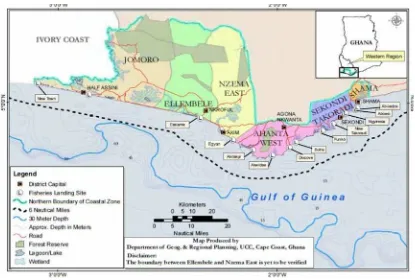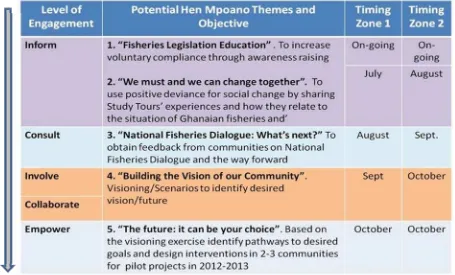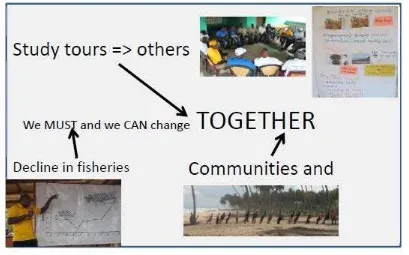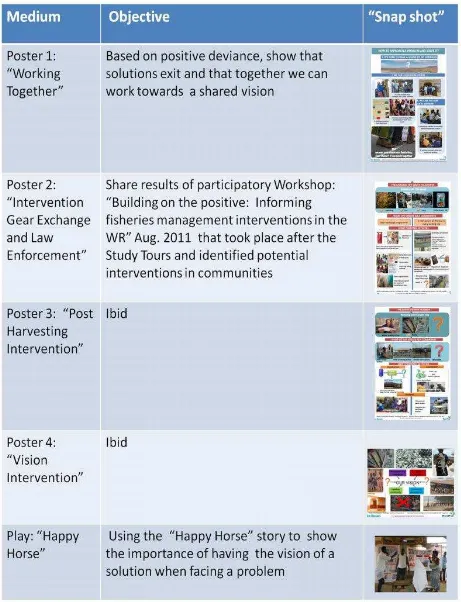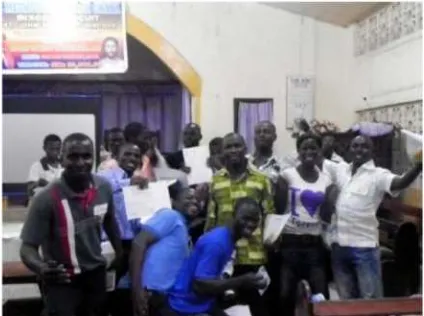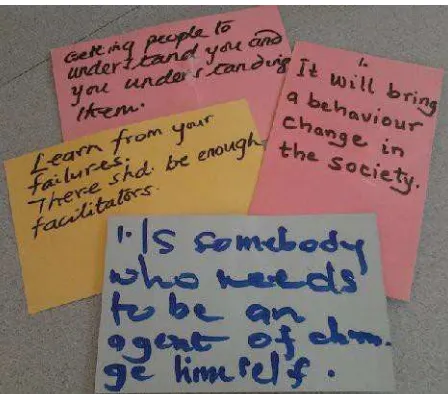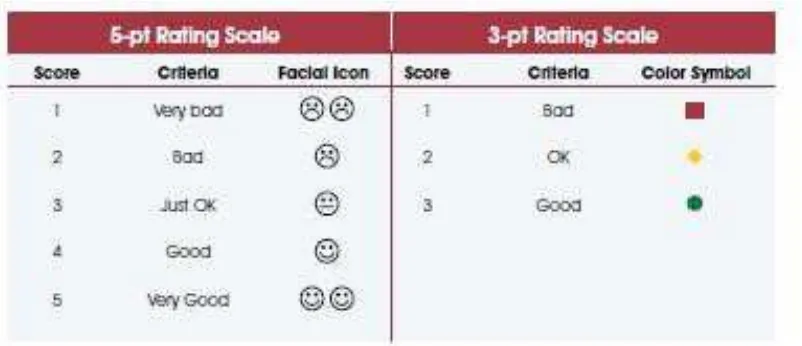TOWARDS ADAPTIVE FISHERIES MANAGEMENT:
PLANNING COMMUNITY ENGAGEMENT IN
GHANA WESTERN REGION
THE
UNIVERSITY
of Rhode Island
GRADUATE SCHOOL Coastal OF OCEANOGRAPHY Resources
This publication is available electronically on the Coastal Resources Center’s website at http://www.crc.uri.edu
For more information on the Integrated Coastal and Fisheries Governance project, contact: Coastal Resources Center, University of Rhode Island, Narragansett Bay Campus, 220 South Ferry Road, Narragansett, Rhode Island 02882, USA. Brian Crawford, Director International Programs at [email protected]; Tel: 401-874-6224; Fax: 401-874-6920.
Citation:
Badjeck, M-C., Amponsah, S. (2012). Towards Adaptive fisheries management: Planning community engagement in Ghana Western Region. USAID Integrated Coastal and Fisheries Governance Program for the Western Region of Ghana. Penang: WorldFish. 28 pp.
For additional information on partner activities:
WorldFish: http://www.worldfishcenter.org
Friends of the Nation: http://www.fonghana.org
Hen Mpoano: http://www.henmpoano.org
Sustainametrix: http://www.sustainametrix.com
Disclaimer:
The study was made possible by the generous support of the American people through the United States Agency for International Development (USAID)/Ghana. The contents are the responsibility of the authors as part of the Integrated Coastal and Fisheries Governance (ICFG) Project and do not necessarily reflect the views of the United States Government. Associate Cooperative Agreement No. 641-A-00-09-00036-00 for “Integrated Coastal and Fisheries Governance (ICFG) Program for the Western Region of Ghana”, Under the Leader with Associates Award No. EPP-A-00-04-00014-00.
The views expressed in this report are those of the author and do not necessarily reflect the views of The WorldFish Centre and USAID. While reasonable efforts have been made to ensure that the contents of this publication are factually correct and properly referenced, the author does not warrant that the information in this report is free from errors or omissions.
Cover Photo: Beach Seiners Western Region
Contents
Figures... ii
Tables ... ii
Acknowledgements ... iii
1. Introduction ... 1
2. Community fora: planning for engagement ... 1
3. Example of tools and material: pilot testing in two communities ... 6
Lesson Learned from pilot testing: ... 11
4. Training Fisherfolk communicators: fostering brokers and agents of change ... 11
5. Monitoring and Evaluation: Identifying “signals of success” ... 13
Report and Score cards: ... 14
Community Score Cards : ... 14
Most Significant Change: ... 15
6. Capacity building of a bridging organisation: Training and planning with the Fisheries Working Group ... 15
Fisheries Working Group: training and 3 month planning ... 15
7. “Take home” messages: some recommendations ... 20
Annex - Terms of references and fieldwork schedule ... 21
I. Terms of references ... 21
II. Activities undertaken ... 21
References ... 23
Figures
Figure 1 Hen Mpoano project area ... 2Figure 2 Planning community fora: Themes ... 3
Figure 3 Story board for Theme 2: We must and we can change together ... 4
Figure 4 Pilot testing communication material during community fora in Awkadaa Western Region ... 7
Figure 5 Youth Workshop activities March 4th and March 6th 2012 ... 10
Figure 6 Youth Workshop March 4th ... 11
Figure 7 Understanding the role of communicators: Fisherfolk ... 12
Figure 8 Monitoring: Meeting tracking forms developed for the pilot testing ... 14
Figure 9 Alternative symbols to aid the scoring process during a focus group (World Bank no date) ... 15
Figure 10 Our story - Fisheries Working Group ... 17
Tables
Table 1 Visual media created for pilot forum: fostering information exchange and dialogue with communities (1) ... 8Table 2 Visual media created for pilot forum: fostering information exchange and dialogue with communities (2) ... 9
Table 3 Planning session with the Fisheries Working Group: linking scales vertically from national to local ... 19
Acknowledgements
1. Introduction
Community engagement to facilitate adaptive management has become a priority for the WorldFish Center and Hen Mpoano in 2011-2012; the need to plan, test, and train partners in community engagement practices is behind the development of this pilot study (The full terms of references and schedule for this consultancy can be found in Annex 1). In summary the pilot study aimed to:
1. Design a draft community fora plan for 2012.
2. Design support material for the community fora to be used by the fisherfolk communicators and tested in the field.
3. Conduct at least two community fora in selected study sites. 4. Provide training to fisherfolk communicators.
5. Assist the Fisheries Working Group Strategic Planning for 2012.
Community engagement can be understood as “the process of working collaboratively with and through groups of people affiliated by geographic proximity, special interest, or similar
situations to address issues affecting the well-being of those people” (Centers for Disease Control and Prevention 1997). It usually refers to activities designed to give the local
community an opportunity to contribute to decision-making and participatory natural resources management. Types and level of engagement are many and target groups can be varied, ranging from youth and women focus group to entire coastal communities.
One of the most important factors contributing to the success of community engagement efforts is a clear and realistic vision shared with partners. In 2012, Hen Mpoano needs to define clearly the objectives of its community engagement; indeed “(...) it is easy to run around, looking busy, arranging meetings (...) talking to community leaders, moving advocacy groups, stimulating action, without moving forward in accomplishing genuine community strengthening. You need to clarify your goals, first to yourself, then on paper, then to those around you.”(Bartle 2007).
The following goals for community engagement are put forward:
• to result in the piloting of alternative strategies to fisheries management.
• to build towards the goal of formulating a nested governance system.
• overall, to foster behavioural change.
2. Community fora: planning for engagement
• Inform: To provide the communities with balanced and objective information to assist them in understanding the problem alternatives, or solutions.
• Consult: To obtain communities feedback’ on analysis, alternatives, or decisions.
• Involve: To work directly with the communities throughout the process to ensure that public and private concerns are consistently understood and considered.
• Collaborate: To partner with the communities in each aspect of the decision, including the development of alternatives and the identification of the preferred solution.
• Empower: To place final decision making in the hands of the communities.
As project activities move along this continuum, it is important to note that time requirements to build trust, relationships and ownership will increase, while the number of communities across the region the project can reach will decrease.
Hen Mpoano targets coastal districts in the Ghana Western Region (Figure 1). During fieldwork in 2011 and 2012 clear concepts of the limits to the human capacity within the project were developed. To address this issue it is proposed that a sequential/phased approach be used to conduct fora in two geographical zones: Zone 1 with Shama,Sekondi/Takoradi, and Ahanta West, and Zone 2 including Jomoro, Nzema and Ellembele districts.
Figure 1 Hen Mpoano project area
Community fora should be conducted between the period of July and October 2012. In
November 2012 an evaluation of community engagement should be undertaken. This exercise will be informed by engagement monitoring undertaken throughout the July- October period (see section 2.4). In December 2012 and January 2013 the implementation of pilot interventions designed selected by communities should be underway. In Figure 2 five themes for community fora are presented alongside their level of engagement.
objective is to increase awareness about the new regulations in order to foster voluntary compliance, the situation whereby regulated parties comply with regulatory requirements of their own accord1. Theme 1 is thus an extension education effort aimed at enhancing public understanding and appreciation of regulations and good fishing practices (e.g. informing of the impact of light fishing on ecosystems) (Helfrich & Griswold 1991). The role of fisheries officers at landing site should thus be revisited; going beyond data collection officers should be trained in the provision of extension services. Extension provides the critical bridge between
government agencies at the regional scale and communities. However the government role in communities is not just as “provider” of information but also as “learner” of community practices and attitudes that hinder compliance. Cavaye (2000) goes as far as stating that communities and government have to “unlearn” together their respective perception of government as solely a provider, an “implementer and oppressor”, and the assumption that government has nothing to learn from communities.
Figure 2 Planning community fora: Themes
For the remainder of 2012 Hen Mpoano should collaborate with the Western Region Fisheries Commission and the newly formed Marine Police Unit in the implementation of additional information sessions in communities which have not been targeted yet. Material and methods of engagement developed by Friends of the Nation could be used in the implementation of this Theme. However government officers will require training in communication and facilitation, shifting from “collecting” and policing activities to providers of information, enablers of change and vehicles for concerns. Redefining their work and role will be challenging and will require commitment and investment from the Ministry of Fisheries and the identification of
“champions” within the Ministry.
Theme 2: “We must and we can change together”, will inform communities about the
situation of Ghanaian fisheries and the 2011 Study Tours’ experiences of Hen Mpoano staff and key community members (Figure 3). The objective is to stimulate behavioural change by
fostering and facilitating wider social change at the local level through the positive deviance approach. As described in Badjeck et al (2011), the positive deviance approach was initially used in health and malnutrition work; researchers observed that despite poverty in a community, some poor families had well-nourished children. The premise was that solutions to community problems already existed within the community: how could this be explained and replicated to other households? (Sternin 2003, Sternin & Pascale 2005). In natural resource management, and more specifically interventions whose focus is institutional and behavioural change, positive deviance is finding situations where on the surface positive changes are taking place.
In Theme 2, learning from others who face similar problem, focusing on successes and
opportunities rather than only challenges and barriers is the objective. The cornerstone of Theme 2 is discovering unique practices or behaviours enabling fisherfolk in other African countries who have access to similar resources to find solution. The community through this discovery process can start determining which aspects of the Study Tours experiences of 2011 could be replicated, focusing on replicating processes rather than identical solutions, solutions being context-specific and contingent on resources and local conditions. During this consultancy material and engagement methods for Theme 2 were developed and will be discussed in Section 2.2.
The objective of Theme 3: “National Fisheries Dialogue: What’s Next?”, is to inform and obtain communities’ feedback on the National Dialogue that took place in Ap ril 2012. The aim of the dialogue was to engage stakeholders in the fisheries sector in discussions for the
identification of options to implement co-management in Ghana. The Hen Mpoano project should identify the key messages of the document “Proceedings of the Ghana Coastal Fisheries Governance Dialogue”2 and design material for community fora using similar processes and tools used to develop material for Theme 2 (e.g. posters, banners).
2pers. communication with WorldFish Staff Tendayi Maravanyika on National Fisehries Dialogue
With Theme 4: “Building the Vision of our Community”, the objective is for communities to identify their desired vision for the future. Communities will explore normative scenarios, defining desirable outcomes and exploring the paths leading to these goals (“What do we want the future to be?”). Scenario or visioning exercises are typically used in the context of planning over long time horizons or short-term decisions that have long-term consequences, by widening perspectives and illuminating uncertainties key issues that may otherwise be missed (Mahmoud et al. 2009). In this approach aiming at understanding, embracing, and adapting to uncertainty and surprise is at the core of adaptive management (Olsson et al. 2004, Hughes et al. 2005, Mahon et al. 2008). Since ecological systems are dynamic, management strategies must also incorporate uncertainty, non-linearity, and experiments to learn about the ecosystem (Olsson et al. 2004).
Theme 5: “The future: it can be your choice” is built on the visioning/scenario exercise developed in Theme 4. The objective is for communities to identify interventions helping them achieved or advance towards their vision that could be implemented during 2012-2013. Indeed, once a vision is established, backcasting techniques can be used to answer the following
question: “What do we need to do today to reach successful outcomes and avoid negative ones in our scenario?”. This method was successfully used by the WorldFish Center during a Hen Mpoano training workshop on adaptive management and scenarios in May 2011. Another methods successfully tested by the WorldFish Center in August 2011 is the “Happy Horse game”, an approach normally used in outcome mapping and ex-ante impact assessment which allows the identification of the different steps needed to achieve a vision and implement an intervention (see Badjeck et al. 2011). The key element in this Theme, based on the positive deviance approach, is the belief that solutions and actions to advance towards a desirable goal already exists within the community and need only to be discovered by its members; it is looking at opportunities and potential, rather than only focusing on barriers and problems.
It is proposed that Theme 5 be implemented in two to three communities as pilot studies;
“experiments” in adaptive management. Due to time and human resources constraints the design of interventions and their implementation by Hen Mpoano should focus on specific sites. These pilots will test the methods, process and material developed by Hen Mpoano before proposing to upscale them over the six districts; as an African proverb states “You never test the depth of a river with both feet”. Monitoring and evaluation of the pilots will be critical to define outcome, success and impact as well as identifying if these are replicable in other
contexts. The WorldFish post-doctoral fellow could lead the exercise in at least one community. The interventions should follow the recommendation of the SMART and SPICED approaches typically used for designing project monitoring programs (Larson & Williams 2009) :
• Specific: state what exactly is to be achieved.
• Measurable: make sure it is possible to determine whether or how far it has been achieved.
• Achievable: realistic given the circumstances and resources.
• Relevant: of relevance to the overall vision, to the stakeholders, and to the people responsible for achieving them.
• Time-specific: set realistic time-frames for achievement within the 2012-2013 project year.
• Subjective: include unique insight or experience expressed by communities. What might be seen by some as ‘anecdotal’ becomes critical data because of its source.
• Interpretable and communicable: Locally defined by communities, interpreted and translated for other stakeholders.
• Cross-checked and compared: interventions design must be cross-checked by using different informants, methods, and project staff, and compared to on-going or planned interventions.
• Empowering: designing interventions should be empowering in itself and allow groups and individuals to reflect critically on their changing situation.
• Disaggregated: Different groups of stakeholders might be interested in different aspects of the interventions. There should be a deliberate effort to seek out different perception from a range of groups, especially youth and women.
The last aspect of the SPICED approach raises the issue of “targeted community engagement”. It is important to highlight that community engagement can take various forms, from
community fora to focus group meetings. Fora are considered a central medium to reach
communities in Year 3 but the usefulness of a community forum depends on how representative participants are of the community, target audience, or stakeholders3 . The Senegal study tour highlighted the importance of youth and women involvement in fisheries co-management. Participatory observation during past community forum in Hen Mpoano also raised the issue of women and youth being marginalised in discussion surrounding fisheries. Focus groups as a form of community engagement can address this issue and it is advised that Hen Mpoano designed targeted activities involving women and youth in the between July and October 2012.
To successfully implement the five Themes between July and October 2012 a Research Assistant should be hired to:
• Assist in the design of engagement material for Theme 3 and Theme 4 following approaches used in the pilot testing of Theme 2.
• Assist in the implementation of Theme 2, Theme 3 and Theme 4. The Research Assistant should also assist the monitoring engagement activities.
3. Example of tools and material: pilot testing in two communities
One of the objectives of the consultancy was to design support material for community fora to be used by the fisherfolk communicators. The nine tools used to store and deliver information for the pilot testing of Theme 2 “We must and we can work together” during the community forum in Akwidaa on March 6, 2012 (Figure 4) are presented in Table 1 and Table 2. The overarching objective of the designed material was to share the study tours’ experiences with posters and a video, as well as some of the interventions designed during the Volta River Authority (VRA) workshop held on the 24th - 26th August 2011. The workshop objectives were to give an opportunity to the participants of the Tanzania, Senegal and Ivory Coast study tours to share what they had learned and critically reflect on positive experiences in fisheries management. The workshop participants also identified pilot projects that could be implemented in the Western region. The designed material for Theme 2 also emphasized the need for the community to have a vision, a common objective they can work on together.
Table 2 Visual media created for pilot forum: fostering information exchange and dialogue with communities (2)
As part of the piloting of engagement methods with marginalized groups, one of the leaders of the Youth Club in Dixcove, Honorable Isaac Simmons was contacted. Mr Simmons is also a founder of the Dixcove Fisheries Co-management Forum and became an assembly man
because: “we are marginalized and [I want youth to participate in decision making] that was my motivation to become assembly man”.
After discussions around the needs of the Youth Club, a participatory digital story telling
workshop was put together. Participatory digital story telling is a versatile and powerful tool to bring people together to explore issues, voice concerns or simply to be creative and tell stories; “this process can be very empowering, enabling a group or community to take action to solve their own problems and also to communicate their needs and ideas to decision-makers and/or other groups and communities” (Lunch & Lunch 2006).
participants can then be shared with stakeholders in the Hen Mpoano project through visual material created during the workshop. The event was an opportunity to explore issues in Dixcove and learn advocacy skills. The 16 participants included fishermen, fishmongers, students and teachers. In Figure 5, details of the workshop activities are presented. One of the photo-stories produced during the workshop was presented during the National Fisheries Dialogue in April 2012. Through the National Fisheries Dialogue, the photo-story linked otherwise unconnected actors and was a unique opportunity to share youth’s experience in the coastal community of Dixcove. The story, and its embedded knowledge, becomes a bridging product, increasing cross-scale interaction between a local marginalized group and decision-makers at the regional and national level. The ability to create the right links in a timely manner around relevant issues in multilevel governance is critical to facilitate adaptive responses response and resilience (Olsson et al. 2007). Bridging products should be considered an essential component of the implementation of nested governance in the Hen Mpoano project.
• Participant list and consent forms. • Introduction.
• “Tape Game” to understand the importance of group work (masking tape on the ground at both ends of the room. Participants must cross the finish line together which requires coordination.
• Group work to identify on index cards important issues in Dixcove. Ranking with stones. • Circle game => participants sit in a circle and the camera and Flipcam is passed around
each participants explaining to the other how they work.
• What is digital story telling? Example with image references and videos.
• “Shot game”. Groups go outside on the landing site to take 6 type of shots from close ups to long shots.
• Introduction to storyboards. Group create their own story board and shoot. • Editing two days later with the group.
Figure 6 Youth Workshop March 4th
Lesson Learned from pilot testing:
• The use of diverse media is essential to engage with community and should rely mostly on photos and video.
• The use of the drama group (entertainment-education) needs to be re-defined as during the pilot testing the entertainment value outweighed the educational one. Working with the Director of play based on the “Happy Horse” story will be necessary to obtain a more focused story.
• The targeted engagement approach with the Youth Group proved highly successful. It is advised that Hen Mpoano continues to work with the Youth Group, and explore opportunities to work with women groups in the Ahanta West Region.
• Participatory video and photography should be used, especially in light of the training provided by Media Impact to project staff in March 2012.
• The pilots highlighted that a research assistant will be needed to organize the material for the different themes in collaboration with CRC/Ghana with the communication department, monitor and evaluate fora and assists the communicators.
4. Training Fisherfolk communicators: fostering brokers and agents of
change
Using an adaptive management approach, Hen Mpoano is experimenting with bridging
mechanisms to ensure that in a nested governance system links exist between the local, regional and the national level. In addition to the Fisheries Working Group, the development of
leaders to communicate voluntary compliance messages to fishers”. Expanding this definition, the consultants are communicators that have the potential to act as intermediaries between organizations and scales, becoming scale-crossing brokers or bridging agents in a nested governance system (Ernstson et al. 2010, Robinson & Wallington 2012).
A one-day training was organized with eight communicators and two project staff on February 24th 2012. The objectives of the event with the communicators were:
• To introduce the concept of communication for social change => “Why do we need to communicate?”
• For the group to redefine their role => “The role of the communicator – YOU”
• Prepare the pilot testing in Akwidaa
• Introduce some of the material and topics for meetings and get feedback The training highlighted that:
• Participants had a good understanding of why they are involved in the initiative but might not fully comprehend their roles when organizing community forum, i.e. facilitators, planners, organizers etc.
• Conflict resolution skills are needed. Some communicators expressed difficulties in liaising with chief fishermen and handling difficult questions
• Communication skills such as facilitation are needed
Another issue that emerged during group exercises (Figure 7) is the difficulty of “owning one’s failures” and learning from them. Building the self-confidence and nurturing a safe space for critical reflection is often the least-appreciated part of program involving community
communicators/motivators. On-going training is also necessary to ensure that the
communicators have something ‘new’ to give to the community, and refresher practical courses will maintain motivation and increase learning.
One of the greatest difficulties for community workers who are members of the targeted
communities are the assumption that they will learn on the job, that they know everything about the issue – in theory and practice-, and that they have the skill set to communicate and work with others (for a rare insight into the personal account of a grassroots worker on bridging the gap between biomedical professionals and local communities and her struggle to achieve successful community participation see Maphorogo et al. (2004)).
Figure 7 Understanding the role of communicators: Fisherfolk
ability to foster a positive dialogue. For instance one participant has been extremely attentive and active during the training but group work interaction proved to be difficult. Hen Mpoano needs to evaluate how much additional training can be offered, and if further pilot testing still highlights weakness in some communicators whether the project is ready to let them run meeting by themselves.
After the pilot testing in Akwadaa, which included a debriefing session right after the meeting, some points must be considered for future events in addition to those raised above:
• Timing and delays were an issue and the community started to lose interest while waiting for the communicators to arrive
• Communicating “with” the people and not “to” the people: communicators have to learn not to focus on issues that only interest them (in this case light fishing)
• Another training session and pilot testing is essential. Assante was proposed as it is a small well organized community.
The fisherfolk communicators are an enthusiastic group that could become a critical nexus in nested governance and should be nurtured by the project.
“I was happy with the way the whole program went- was encouraging and there is more room for improvement. The major drawback was lateness. Though there were small hitches, with time ‘we will gain enough experience’. (...) There should be time keepers to assist the speakers especially when they have been assigned time-limits “. Communicator 1
“The message of the program- carbide, light fishing and dynamite issues were irrelevant to the community. This resulted in loss of interest in the program by most community members” Communicator 2
After this comment communicators agreed that speakers should have a list of the topics they intend to talk about.
“FWG, should constantly do follow-ups to collect feedbacks --- this would enable them to know how the community is applying the message delivered by them.” Communicator 3
“Hen Mpoano personnel’s should continuously encourage the FWG” Communicator 4
5. Monitoring and Evaluation: Identifying “signals of success”
Monitoring and evaluation (M&E) is essential to measure the extent of progress and achievement of the community engagement process, to foster accountability towards communities, and to institutionalize learning. As with other types of monitoring, monitoring engagement can occur at different time steps including (Larson & Williams 2009):
• Monitoring of the engagement process itself: this type of monitoring can be
initiated over the short term. Effectiveness can be monitored and the process can be adjusted for improvement (July until October 2012).
• Monitoring of outputs: this monitoring can be initiated at the end of the engagement process itself, as a tool for evaluation of the process completed (November 2012).
• Monitoring of outcomes: requires longer time lines as well as evaluation of a wider set of drivers and conditions; it focuses on the actual effectiveness of the engagement process as an agent of change.
• Monitoring of unintended consequences: Learning will be greatly enhanced if the system allows for monitoring of unintended consequences, as well as the
Final evaluation of the community engagement process 4 should be built into the engagement monitoring plan.
In Hen Mpoano, monitoring is a necessary tool to identify “signals of success”, how the project facilitates changes, as well as unintended (positive or negative) consequences. Participatory monitoring, involving communicators and target groups/communities, is put forward for the project to assess:
• the development of a nested governance system.
• the piloting of alternative strategies to fisheries management.
• and steps towards behavioural change.
Monitoring used to be limited to systematic quantitative data collection (number of meetings, participants, communities targeted) to provide project management and indication of success. However, these measures do not provide insight into the potential behavioural changes and do not leave room for reflexivity and learning.
For engagement monitoring similar tools than project monitoring can be used. Below we present three tools; the objective is no to provide an exhaustive review or a monitoring plan for the project, but rather open a dialogue on this important issue amongst the project team and the communicators.
Report and Score cards:
Reporting forms for communicators were tested during fieldwork (Figure 8). These forms are simple, require little time to fill, and are cost effective. However, a significant weakness was observed during the pilot: self-reporting lead to “embellishing” the event (# of participants, positive feedback only etc.).
Figure 8 Monitoring: Meeting tracking forms developed for the pilot testing
Community Score Cards :
Community score cards can be used to gather feedback and improve communication between communities and communicators (Figure 9). Feedback provided via focus group must be immediate (same day or next few days) and requires good facilitation skills; the communicators could be accompanied by a research assistant with experience in facilitation.
Figure 9 Alternative symbols to aid the scoring process during a focus group (World Bank no date)
Most Significant Change:
Most Significant Change (MSC) is a form of participatory monitoring and evaluation
particularly adequate for building community ownership, and when it is not possible to predict in any detail or with any certainty what the outcome will be. Focused on social change,
participatory in ethos, it is designed with repeated contact between field staff and participants (Davies & Dart 2005). The MSC process involves the (self-) recording of participants
experiences , the collection of stories, and the systematic selection of the most significant ones by panels of designated stakeholders or staff in addition to partners and beneficiaries. MSC requires an organisational culture where it is acceptable to discuss things that go wrong as well as success, good facilitation skills, and a willingness to try something different and engage over time.
6. Capacity building of a bridging organisation: Training and planning
with the Fisheries Working Group
Fisheries Working Group: training and 3 month planning
The objective of the work undertaken with the Fisheries Working Group (FWG) was two- fold:
1. To introduce the concept of adaptive management. Using the example of the Atlantic cod collapse in Canada, the importance of learning, experimenting and the role of fishers was highlighted. This activity was undertaken on March 1st 2012.
2. To offer a space for reflexion on the role and objectives of the FWG. This was followed by a planning session in groups, undertaken March 2nd2012.
Unfortunately the entire FWG was not present (six members the first day, seven the second one). It was suggested by a WorldFish staff member that the introduction on adaptive management be repeated again.
• Action item: Convene a session with the entire FWG on adaptive management. It is
suggested that material from Marie’s presentation and Dave training in May 2011 be
used. Responsible: WorldFish
The story of the “cod collapse” exemplified for the group the potential dangers of
overexploitation: “You can’t imagine there will be nothing tomorrow”, “catching a lot those not mean there is a lot” and “ignore the signs but the consequences will still come”. The
participants reflected on the need to create compelling stories for fisherfolk to understand that a collapse is possible, has happened in other countries, as well as in Ghana with the trigger fish story of collapse. In addition, the economic impacts of the collapse in Canada highlighted the need to show that fisheries in the Western region contribute significantly to the social fabric of coastal communities and the local economy.
Action item: explore if it is possible to prepare two simple fact sheets including
pictures/graphs on the collapse of trigger fish and the importance of fisheries in Ghana.
Responsible: FON with help from WorldFish
b. Planning session:
The first part of this session focused on the basic concepts of advocacy and a reflection on what the FWG should be. Based on the work of Marshall Ganz and the New Organizing Institute5, the “story” approach was used as a tool to capture participant’s perception of their role and the FWG’s role.
“story of self” tell why you have been called to be part of the group => why you are here
“story of us” tell the values and experiences that you share and the capacity and resources you have to accomplish the group’s goals => why the group exist
“story of now” tell what is the urgent challenge that called you to take action => what is the problem!
In Figure 10 the results of the group work can be found.
The exercise highlighted that the FWG is considered by its member as:
• a knowledge and information sharing platform among members
• advisory group for the Fisheries Commission
• a link between the local level (communities) and regional/national level The participants thus consider the FWG as a bridging organization, which provides “(...) an arena for trust-building, sense-making, learning, vertical and horizontal collaboration, and conflict resolution (Hahn et al. 2006).” (Olsson et al. 2007). In the design of nested governance systems, bridging organizations are essential for the management of complex systems.
During the debriefing meeting with CRC/FON staff on March 7th it was highlighted that while the FWG had terms of references (TORs) designed by Hen Mpoano, it was necessary for participants to shape the group and its future, adding a “story of then”, a visioning exercise for 2012. This will ensure that an exit strategy for Hen Mpoano can be designed and stimulate discussion about which tasks should be allocated to whom in a vertically nested governance
system.
Action item: FON to lead a Visioning exercise for 2015 during one of the FWG meetings
before end of July revisiting “our story” approach combined with visioning methods.
Responsible: FON
During a planning session and using a modified outcome mapping approach, two groups were created based on issues that the FWG feel it must tackle in 2012 (“change we want to achieve in 2012”):
• 60% compliance in the six coastal districts through education on the importance of compliance and raising awareness about the FWG at the community level while at the regional and national level advocating for provision/subsidy of legal size nets and more education
• Raise the profile of fisheries by creating a communication at the district level in the 6 coastal districts
The tables are the results of a discussion surrounding a 3 month planning of activities that could help achieve these objectives. Some revisions and suggestions are needed to link this planning with the FON planning and make sure it is implementable. The activities will be amended for the next draft.
Table 3 Planning session with the Fisheries Working Group: linking scales vertically from national to local
Show case the group to all the communities in the 3
coastal districts for informative meeting.
3 members from the group at each meeting. Group
should include members from FWG & FC
April
Regional minister Importance of compliance
FWG meets the Regional minister to introduce their
VISION and PLAN Prepare summary of members of
the group, vision/objective and story of us and story
of now
End of
March Early April suggested after a meeting with
FON/CRC/WF
2. Other actors should be involved
in education at the community
level like the District Assembly reps
and fisheries officers (must work
effectively)
FWG meet before the National Dialogue to prepare
their key message for the event
Table 4 Planning session with the Fisheries Working Group: linking scales vertically from national to local
7. “Take home” messages: some recommendations
• Types and level of community engagement are many and target groups can be varied. In addition to community fora, focus group activities with women and youth should be undertaken.
• The objectives of engagement must be focused and shared with project partners and beneficiaries. For the implementation of community fora a sequential/phased approach is suggested between July and October 2012 around five themes.
• The quality of engagement, including adequate support material, time invested in communities to understand needs and build trust, is better than aiming only at the quantity of communities targeted.
• Fisherfolk communicators have the potential to act as intermediaries between organizations and scales, becoming scale-crossing brokers or bridging agents in a nested governance system. However, “not all communicators should be
communicators”; the project needs to invest in training and identify key individuals that can act as brokers and agents of change.
• Monitoring and evaluation is necessary to identify “signals of success” and Hen Mpoano needs to design a M&E plan for engagement activities that goes beyond reporting number of events and tries to capture behavioural change as soon as possible.
• The Fisheries Working Group can be considered a bridging organization but
Annex - Terms of references and fieldwork schedule
I. Terms of references
1. Develop a workplan for Ghana field trip in collaboration with the project leader. 2. Design a community fora plan for 2012 to be discussed with the project team in
Sekondi, including terms of references for the project fisherfolk consultants. 3. Design support material for the community for a to be used by the fisherfolk
consultants and tested in the field.
4. Conduct at least two community fora in selected study sites.
5. From the need assessment survey and survey of Senegal study tour participants (especially pre-departure survey) design a capacity building and dialogues program for 2012.
6. Submit a draft report to be discussed with the project leader and team in Sekondi and a final report.
II. Activities undertaken
The table below presents the activities undertaken during the 2 weeks in Ghana out of the 28 days consultancy. Highlighted in grey, community, training and workshop events
conducted.
Tuesday, 21 Feb Departure from Penang
Wednesday, 22 Feb Arrival in Accra 12:40PM Sekondi 3PM Meeting in CRC office
Thursday, 23 Feb Discussion and feedback session about TORs the community material in a morning session with CRC team + preparation of material with Samuel
Friday, 24 Feb 9-13PM training and role play with fisherfolk community agents => better understanding of their role and additional leadership. Venue:@CRC office. Preparation of communication material and community forum with Samuel (afternoon)
Saturday, 25 Feb Interview with Honorable Isaac Simmons Fisheries co- management group and youth club Dixcove
Sunday, 26 Feb Finish preparing community material CRC office
Monday, 27 Feb Finish preparing community material CRC office
Tuesday, 28 Feb Finish preparing community, youth workshop material and Fisheries Working Group meeting CRC office
Wednesday, 29 Feb Prepare meeting with FWG
Thursday, 1 Mar 2PM Meeting with FWG
Saturday 3-Mar Finish preparing community and youth workshop material
Sunday 4-Mar Dixcove Youth event
Monday, 5Mar Finish preparing community for a material
Tuesday, 6 Mar Community Fora 1 Akwidaa
Wednesday, 7-Mar Debriefing AM. Departure afternoon from Sekondi flight, 18:45PM
Thursday, 8 Mar Accra for Penang
References
Badjeck M-C, Delaporte A, Asare C, Amponsah S, Boateng Ameyaw A, Adu Obeng P, Mills D (2011) Capacity development and information base for improved fisheries management in the Western Region. Draft Report, The WorldFish Center, Penang
Bartle P (2007) Getting Prepared: Mobilizer
Guidelines http://www.cec.vcn.bc.ca/cmp/modules/pre-int.htm . Accessed 25/04/2012
Cavaye JM (2000) The Role of Government in Community Capacity Building, Department of Primary Industries and Fisheries Information Series QI99804. Queensland Government. Centers for Disease Control and Prevention (1997) Principles of community engagement (1st ed.), Vol. CDC/ATSDR Committee on Community Engagement, Atlanta (GA)
Davies R, Dart J (2005) The ‘Most Significant Change’ (MSC) Technique A Guide to Its Use, http://www.mande.co.uk/docs/MSCGuide.pdf. Accessed 20/06/2012
Ernstson H, Barthel S, Andersson E, Borgström ST (2010) Scale-crossing brokers and network governance of urban ecosystem services: the case of Stockholm. Ecology and Society 15:28. [online] URL: http://www.ecologyandsociety.org/vol15/iss24/art28/
Helfrich LA, Griswold BL (1991) PubIic Education in Fisheries: A Review of the RoIe of Extension. Reviews in Aquatic Sciences 4:317 - 337
Hughes TP, Bellwood DR, Folke C, Steneck RS, Wilson J (2005) New paradigms for
supporting the resilience of marine ecosystems. Trends in Ecology & Evolution 20:380-386
International Association of Public Participation (2007) IAP2 Spectrum of Public
Participation http://www.iap2.org/associations/4748/files/IAP2%20Spectrum_vertical.p df Accessed 15/02/2012
Larson S, Williams L (2009) Monitoring the success of stakeholder engagement: Literature review. In: Measham T, Brake L (eds) People, communities and economies of the Lake Eyre Basin, DKCRC Research Report 45, Desert Knowledge pp. 251-298. Cooperative Research Centre,, Alice Springs
Lunch N, Lunch C (2006) Insights into Participatory Video – A Handbook for the Field http://www.insightshare.org/training_book.html, Insight (UK)
Mahmoud M, Liu Y, Hartmann H, Stewart S, Wagener T, Semmens D, Stewart R, Gupta H, Dominguez D, Dominguez F, Hulse D, Letcher R, Rashleigh B, Smith C, Street R, Ticehurst J, Twery M, van Delden H, Waldick R, White D, Winter L (2009) A formal framework for scenario development in support of environmental decision-making. Environmental Modelling & Software 24:798-808
Mahon R, McConney P, Roy RN (2008) Governing fisheries as complex adaptive systems. Marine Policy 32: 104-112
Maphorogo S, Sutter E, Jenkins J (2004) The community is my university: a voice from the grass roots on rural health and development., Vol. Koninklijk Instituut Voor de Tropen (KIVT). p.272
Olsson P, Folke C, Berkes F (2004) Adaptive Comanagement for Building Resilience in Social– Ecological Systems. Environmental Management 34:75-90
Kristianstads Vattenrike Biosphere Reserve Sweden. . Ecology and Society 12:28. [online] URL: http://www.ecologyandsociety.org/vol12/iss21/art28/
Robinson CJ, Wallington TJ (2012) Boundary work: engaging knowledge systems in co- management of feral animals on Indigenous lands. . Ecology and Society
17:16. http://dx.doi.org/10.5751/ES-04836-170216
Sternin J (2003) Positive deviance: A new paradigm for addressing today’s problems today. Journal of corporate citizenship 5:57-62
Sternin J, Pascale R (2005) Your Company’s Secret Change Agents. Harvard Business Review May 2005:1-9
World Bank (no date) How-to Notes Rapid Feedback: The Role of Community Scorecards in Improving Service Delivery, Social Development Department, World
Bank. http://siteresources.worldbank.org/EXTSOCIALDEVELOPMENT/Resources/244
362-1193949504055/4348035-1296838689014/7712311-1298494972121/Rapid-Feedback.pdf.
